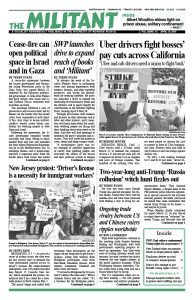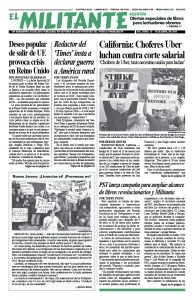High-level negotiations continue in the yearlong trade dispute between Beijing and Washington with both governments reporting progress toward an agreement. Any short-term reset of trading relations would ease tensions, but won’t resolve the rivalry between the two biggest players in the world capitalist economy. While Washington remains dominant, China’s rulers have a long view and see a future where they’re on top.
The U.S. imperialist rulers are using their waning — but still greater — economic and military preponderance worldwide to try to set back this inexorable rise of Beijing. When China joined the World Trade Organization in 2001, following a decade of negotiations after the Cold War, the U.S. and other imperialist rulers welcomed Beijing’s open embrace of capitalism. Now Washington seeks to parry the Chinese rulers’ use of protectionism, theft and spying — measures used by the U.S. rulers and other previous rising capitalist powers to get on top.
Washington has levied heavy duties on about half of Chinese imports into the U.S., claiming it is contesting “economic aggression” by Beijing. President Donald Trump is trying to force more openings for U.S. bosses’ and bankers’ trade and investment. These moves have slowed economic expansion in China.
This deepening global competition comes as renewed concerns of an international economic slowdown compounded by political dislocations have gripped capitalist investors.
After the Trump administration imposed the tariffs last July, in a bid to force concessions from Beijing, the Chinese rulers imposed retaliatory duties on agricultural and other imports from the U.S. The White House threatened more comprehensive tariffs last November, but both governments suspended further retaliatory moves as negotiations continued.
Chinese and U.S. trade officials have been working on an overall agreement in preparation for a summit between Trump and Chinese President Xi Jinping. U.S. negotiators say they are making progress in imposing Washington’s will.
Trump is pushing on long-held U.S. complaints about technology transfers imposed on foreign investors in China, the lack of protection of intellectual property rights there, the inability of U.S. and other foreign firms to take majority ownership over companies in China, and rampant cyber theft. Washington also objects to Beijing subsidizing its state-owned enterprises.
Even if an agreement is reached, some tariffs may be continued on Chinese goods for “a substantial period,” to ensure Beijing’s continuing compliance, Trump warned March 20.
Shifts in economic relationship of forces
The U.S.-China trade rivalry is part of greater shifts in the relationship of forces among competing capitalist nations worldwide.
The combined economic activity of capitalist economies in Asia will by next year outweigh that of the rest of the world in sheer size. By some measures, China, with over four times the population of the United States, will soon supersede the U.S. as the largest economy. India has displaced Japan and Germany to be number three. Indonesia by 2023 is expected to replace Russia at number six.
These shifts are accelerating the coming apart of the European Union. The European Commission, the bureaucracy that supposedly unites and rules over the rival European capitalist powers, issued a statement March 22 branding China as a “systemic rival.”
The Trump administration has been pressuring European governments not to allow China’s largest tech company, Huawei, to bid on their new 5G wireless and technology infrastructure projects, on the grounds of national security.
French President Emmanuel Macron claimed March 22 that “the time of European naivete is ended,” saying that China “took advantage of our divisions.” He called for European rulers to more effectively hunker down to protect their interests against Beijing.
But the fact is that rather than greater unity, the EU operates to the advantage of the more powerful capitalist powers — especially Berlin and to a lesser degree Paris — sucking wealth out of the weaker southern and other states.
A recent visit to Europe by Chinese President Xi to promote Chinese investment there shows these divisions, as each ruling class on the continent pursues its own national interests more openly.
The Chinese leader signed a memorandum with the capitalist rulers in Rome March 23 to join Beijing’s international “Belt and Road” initiative. Rome is the first of the larger European countries to break ranks to join the Chinese initiative, following 13 central and east European nations, as well as many in Asia.
The initiative is a series of vast infrastructure projects linking the markets of Eurasia by land and sea. The name is a nice sounding phrase meant to sugarcoat Beijing’s push to expand investment and influence, and, if government’s can’t pay, to seize ports and properties abroad. Washington has raised the alarm over Belt and Road being used to extend Chinese power — and competition — as well as creating a “debt trap.”
Xi met March 26 with German Chancellor Angela Merkel, Macron and European Commission President Jean-Claude Juncker.
Merkel said the initiative was an “important” project for the German rulers too, stressing their economic “interdependence” with China. Duisburg in the Ruhr Valley already functions as the Belt and Road terminal for northern Europe. Macron is happy for European-based Airbus — a joint project led by French, German and Spanish capital — to conclude a multibillion euro deal for Chinese airlines to buy 300 of its planes. The Boeing bosses’ troubles over their grounded 737 MAX jets made this easier.
One Macron supporter told the English-language online Asia Times March 27 that “Europe” had “28 different policies, with countries competing against each other to attract investment.” Unity against Chinese economic penetration in Europe appears to have gone out the window.

